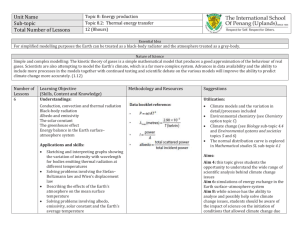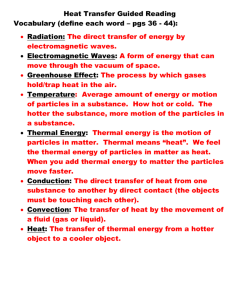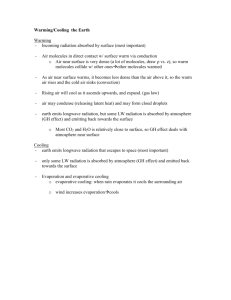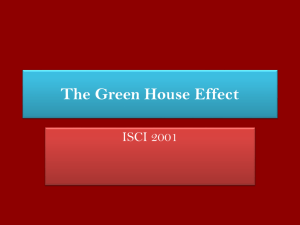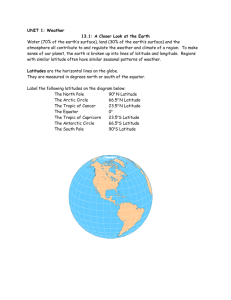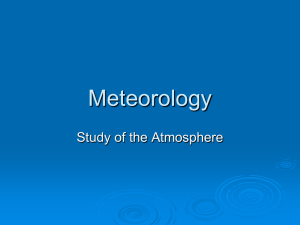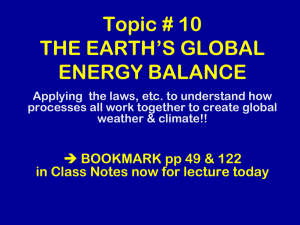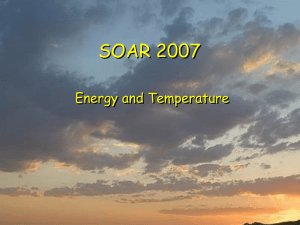Heating the Earth
advertisement
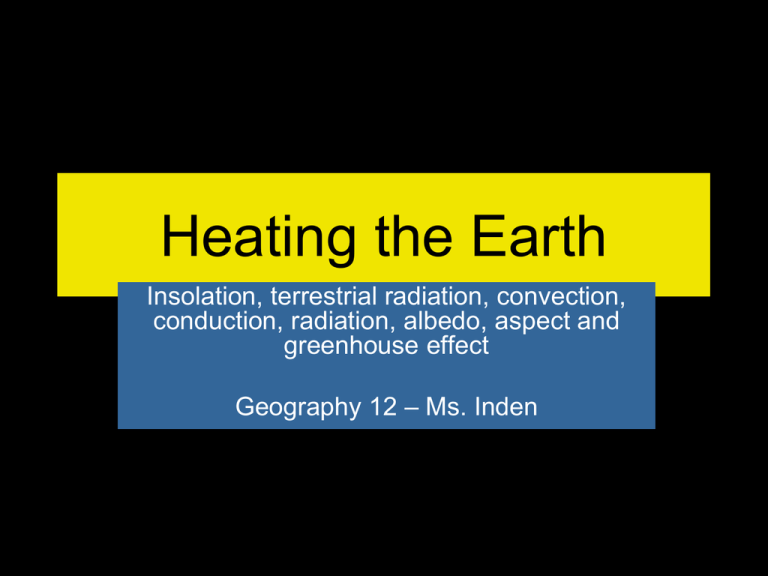
Heating the Earth Insolation, terrestrial radiation, convection, conduction, radiation, albedo, aspect and greenhouse effect Geography 12 – Ms. Inden How is the Earth heated • Energy makes things move • Radiation from the sun is energy – Radiant energy moves in waves or rays – The shorter the wavelength, the more energy • Radiant energy can be reflected by or absorbed by objects – The atmosphere and the earth are absorbing and also reflecting heat energy • When the energy is absorbed, molecules in objects to move, therefore creating heat • Radiant energy powers the water cycle and wind Reflection or Absorption • Radiant energy can be reflected by or absorbed by objects – The atmosphere and the earth are absorbing and also reflecting heat energy • When the energy is absorbed, molecules in objects to move, therefore creating heat • Radiant energy powers the water cycle and wind Conduction http://www.qrg.northwestern.edu/projects/vss/docs/ thermal/1-how-does-heat-move.html • Heat energy is transferred to matter (the atmosphere the ocean, or the earth’s surface) • The molecules and atoms in the matter start to move, and they in turn bounce into other molecules, cause heat to move through the object • Important concept for weather! • Air pressure is the weight of air • The atmosphere has areas of high and low pressure • Why? – Gravity pulls air down – Weight of the column of air pushes down on the lower air What is Air Pressure? Convection • Convection is when a substance that can flow (like water and air), is heated IN THE PRESENCE OF GRAVITY • It creates a cycle of rising and falling matter • This moves heat energy around the ocean and the atmosphere Why don’t the tropics get hotter and hotter, and the poles colder and colder? • Remember that the earth’s tilt on its axis (23.5 degrees) keeps the poles tipped away or toward the sun during the sun and winter respectively • This difference drives atmospheric circulation as the heat moves from the surplus at the equator to the deficit at the poles –Air pressure is different in cold and warm air masses and it wants to equalize – from the highs to the lows – more on this later • This movement also takes place during night and day changes in temperature • It also occurs as temperature differences exist over land and water next to each other • The scientific principle here is convection – warm air rises, cools, and falls back to earth Insolation • Remember that insolation is solar radiation that is received by the earth’s surface http://pilotgcseradicalgeography.co.uk/2006/10/09/why-is-antarctica-cold/ Why doesn’t the earth just keep getting hotter? • Energy is absorbed, but it is also reflected back into space Short wave Long Wave http://mrsdlovesscience.com/greenhouse/greenhouse.html http://greenerloudoun.wordpress.com/climate/ • 24% is absorbed by the atmosphere • Clouds reflect about 23% (and absorb 3%) • About 45% of incoming radiation reaches earth’s surface – 24% as direct – 21% as diffuse radiation – this happens because the radiation is first deflected by molecules in the atmosphere and is SCATTERED in all directions. Some of this scattering reaches the earth’s surface • Terrestrial (earth) radiation is when the earth radiates the heat back out into the atmosphere – Only 4% of this reaches outer space Figures are variable (how thick is the cloud cover, how much water vapour is in the atmosphere, etc) Follow the link to look at the natural and human-made greenhouse gases • http://mrsdlovesscience.com/green house/greenhouse.html What is albedo • A ratio that describes how reflective an object is • How much light is absorbed or reflected by the surface • Fresh snow has a high albedo • Dark objects have a low albedo • The earth has a wide variety of surfaces that also change with the seasons or human activity. • Albedo matters to how much heat energy is absorbed by the earth’s surface – If the surface reflects heat, evaporation does not occur, thereby impacting the formation of cloud and precipitation – In areas that have been deforested or overgrazed by cattle, the albedo becomes higher, thereby causing a reduction of precipitation and a greater likelihood of desertification Take a look at the text • • • • • Look at and draw the diagram on page 15.4 on page 246 that shows the consequences for the natural environment of the fact that air cools as it rises Read on the same page about anomalies (something that is different than you would expect) with regard to the fact that mountain tops are colder than valley bottoms – this is called an inversion. Take note of what an inversion is in your book. The diagram on the next page – Fig. 15.6 is a good look at why the heat on the earth’s surface and air pressure cause higher elevations to be cooler. Copy this diagram into your notes. It is important to understand the idea of microclimates (p. 252). Please note that the textbook uses the term exposure for aspect. Aspect is which compass direction a slope of a hill faces. Obviously, a slope that faces the sun will be warmer than a slope that lies in the shade. If a valley is facing in the direction of the prevailing winds will also be cooler because the wind will blow away the heat radiating off the earth. Urban microclimates – Take a few notes on heat islands (cities) – give several important reasons why cities are hotter than the surrounding country-side. What are some city planners doing to solve these problems?


